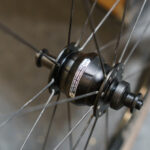Upgrading a classic steel frame bicycle with modern components can bring a unique blend of vintage aesthetics and contemporary performance. Many cyclists appreciate the enduring charm of Retro Style Bikes, but also desire the enhanced braking power of disc brakes. My personal experience with modifying a couple of Moots bikes highlights the feasibility and benefits of such upgrades.
I initially acquired a Jamis bike for a mere $300 as a complete setup. To enhance its versatility, I incorporated a Surly Ogre fork, priced at $100, for rigid riding configurations. My collection also includes two Moots bikes, with the older 1997 26-inch model boasting over 15,000 miles after a disc tab upgrade. Impressed by its performance, I later added a 2008 29-inch Moots to my stable, essentially a larger-wheeled version of the same beloved bike. The framebuilder who expertly added the rear disc tab ensured its precise placement, a crucial detail for optimal braking.
Alt: Surly Ogre fork installed on a classic steel frame bike, showcasing a robust upgrade for retro cycling.
For my weight of 165lbs, a 160mm rotor on the rear provided ample stopping power, and I never felt the need for anything larger. The Surly Ogre fork, which I experimented with on the older Moots, could easily accommodate a 203mm rotor if desired. However, a 160mm rotor both front and rear proved more than sufficient, even when tackling steep descents fully loaded with 65lbs of bikepacking gear. The vintage Moots frame demonstrated remarkable strength and resilience to handle disc brakes, even without additional support gussets often seen on seat stays and chainstays. It has consistently performed reliably for several years post-disc brake modification, proving the durability of quality steel in retro style bikes.
The Surly Ogre fork I utilized on the older Moots bike is noteworthy for its tire clearance. While specific details are available on Surly’s website, I can confirm it comfortably fits a 29×2.5 tire, suggesting compatibility with a 27.5×5 tire as well. However, the older 26-inch Moots frame has inherent rear tire clearance limitations typical of retro style bikes. It comfortably accommodates a 26×2.2 tire or a 700x32c. Even my 29-inch Moots is limited to a 29×2.3 tire; wider tires cause side knob rub against the chainstays during climbs due to frame flex, a consideration when pushing the limits of tire size on older frames.
Alt: A Moots 26er retro bike upgraded with disc brakes, highlighting the blend of classic frame and modern braking.
My personal cycling journey has primarily involved 26-inch and 29-inch wheels. Apart from a single week-long rental experience abroad, I have never personally ridden a 27.5-inch wheel bike. This direct transition from 26 to 29 inches reflects a preference for these wheel sizes in my riding style and perhaps highlights a common path for cyclists who have experienced the evolution of bike technology from retro to modern.
In conclusion, upgrading a retro style steel frame bike with disc brakes can be a rewarding endeavor, enhancing braking performance while retaining the classic appeal. My experience with Moots bikes demonstrates the robustness of older steel frames and the compatibility with modern upgrades, offering a compelling option for cyclists who appreciate the best of both vintage and contemporary cycling worlds.

